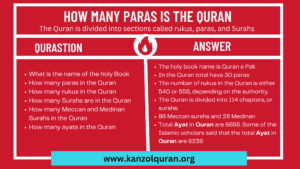The Quran is highly valued by Muslims worldwide, not only for its message but for the organization of Text so that anybody can easily read, memorize, or meditate upon it. A typical inquiry readers pose relates to the number of paras in the Quran. The Quran is in 30 parts; there are no chapter and verse numbers: the Quran is laid out in 30 parts, or ‘pars’ ‘juz,’’ and the intention is that people should approach the Quran with manageable portions in measured increments—daily readings if you like.
This article will examine the arrangement of the Quran’s 30 paras, the rationale for this division, and its implications for understanding and utilizing the teachings in the holy book.
How Many Paras Is the Quran? Character of the 30-Part Division
As a solution to the question, “How many paras is the Quran?” – the Quran comprises 30 equivalent paras. This division aims at several functions that make the Quran easy to use, though it is systematized to cater to different readership needs and interests.
- One Para a Day: This division is instrumental during the holy month of Ramadan, in which the Muslims endeavour to read or recite the Quran from the beginning until its end within thirty days, with one para every day. This daily goal provides a cut-and-dried plan to finish the Quran, broken up systematically in terms of the desired time frame.
- Memorization Support: The 30 paras greatly help memorize the Quran because one can study one part without worrying about others. Playing in small parts makes it easier to handle and retain the verses in the Quran for a long time.
- Thematic Organization: Sometimes, each paragraph brings together themes or sections from different surahs so readers can ponder the other lessons, stories, or teachings explored in each part. This variation in themes in each paragraph assists in enriching one’s insight into the Quran’s direction.
Beyond Paras: How the Quran is Organized with Page Numbers and Rukus
The Quran is 604 pages long, with 558 rules and 30 paragraphs. Familiarizing readers with these additional divisions helps them use the Quran purposefully and effectively.
Pages in the Quran
There are generally different editions, but the size of the Quran is 604 pages for printed copies. Such pages are bordered with significant divisions for the para of each number, every surah, ruku, etc., making arranging their reading or recitation easier.
Rukus as Smaller Sections
In studying the Quran, para is again broken down into smaller units called unrest, which are sections in the Quran Text. Altogether, there are 558 ruckus in total, and they function as logical interruptions of the para, which have a flow and are suitable for taking a break for the moment of reflection or taking a pause and continuing the recitation. For example, each ruku contains a comment on a picture, a change of topic, or a transition between two stories with visions and prophecies aimed at making it easier for people to understand the meaning and importance of each part.
The Role of Thirty Paras Structure in Recitation of Quran and Prayer
It is not just about how the Quran is divided structurally; even its division into 30 parts has significant practical and spiritual significance for Muslims worldwide.
Enhancing Recitation and Reflection
This is because the 30-part division allows treasury followers to make the Quran recitation part of their lives, helping organize worship. One part each day can be read, invoking the Quran for daily readings, which take time to reflect upon teachings from the holy book. This kind of practice is thought to enhance the spiritual relationship with God and remind one of the teachings of the Quran when going through their day.
Supporting Memorization and Learning
A part of Islam’s tradition is memorization, divided into 30 potential parts. Each part serves as an achievement peg that helps students and memorizers (Hafiz) target their goals suitably. The para-based approach subdivides the Quran into little portions that people can memorize progressively; this would explain why it is easier for both the child and the adult to memorize if they started memorizing the Quran.
Leading: Worship in Ramadan
The Quran is divided into 30 parts, each corresponding to the 30 days of the lunar calendar during the fasting month of Ramadan. It is a common practice for Muslims to read or recite one para every day so that by the end of a Muslim holy month, they have to read the Quran thoroughly. It has much spiritual value and is characteristic of the Quran as a book of guidance and spiritual contemplation during these days of increased prayer.
Regarding the Surahs and Ayat within the Paras, the message conveyed in each Surah and Ayat can be understood simply by following the instructions.
In detail, each para consists of fragments of one or several surahs subdivided into ayat or verses. The Quran comprises 114 surahs, each different from the others by bynd motif. Surahs are very different in size: the shortest consists of three verses (Al-Kawthar), while the most extended – Al-Baqarah – has 286 verses.
Understanding Surahs and Ayat Within the Paras
- Meccan and Medinan Surahs: Islamic scholars divide surahs into two groups according to where the surah was recited. Meccan surahs are brief and usually in rhymed prose to enunciate theory on the beliefs, while the Medinan surahs look at practices and are longer and in prose to set down the practice for Muslims.
- Placement in Paras: Organized to read and recite conveniently, thirty parts of the Quran, unfortunately, have cut many large surahs into halves or fractions or combined many small surahs into one. This makes it possible to read constantly when moving from one surah and subject to another without interruption.
FAQ: Here are your Questions Answered Regarding the Framework of the Quran
1. How many paras is the Quran?
The Quran’s textual structure divides it into thirty equal parts called juz, which is also convenient for recitation and memorization.
2. What is the reason behind 30 paras in the QURAN?
It also allows Muslims to facilitate passages where they can recite one para daily for a month, especially during Ramadan.
3. Is the Quran in pages or chapters? How many of those?
The Quran consists of 604 pages. However, the number may slightly differ with the publishers.
4. What is a ruku in the Quran?
A ruku is a sub-division of a para designed to make it easy to pause at intervals that are likely to be convenient. In the Quran there are 558 rukus and 116 are from surahs Al Baqarah and Al Imran.
5. What do surahs have to do with paras in the Quran?
Thus, the Quran has 30 parasites, consisting of parts of one or several surahs.
Conclusion: The rationale of the 30 Paras of the Quran
The dividing of the Quran into 30 paras is a doubling convenience feature as well as the spiritual aspect that makes the reading, recitation, or understanding of the book enjoyable. This structure allows readers to engage the Quran systematically, from its cover, in a month, month, monster moment month, and memorize the Sacred Texts, or daily as the basis on revealed. As a result, Muslims and students of the Quran can more effectively learn about and embrace the guidance of this Text and find structure, clear direction, and meaning in each part, specifically in how many paras the Quran is.




